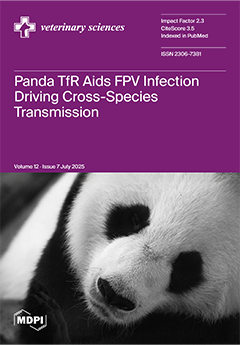This study evaluated the effect of biochars on growth performance, nutrient digestibility, carcass yield, bone mineralization, litter quality and footpad lesions in broilers. Eight hundred day-old chicks were randomly divided into four treatments, 10 replicates per treatment (20 birds/replicate) for 35 days. Treatments
[...] Read more.
This study evaluated the effect of biochars on growth performance, nutrient digestibility, carcass yield, bone mineralization, litter quality and footpad lesions in broilers. Eight hundred day-old chicks were randomly divided into four treatments, 10 replicates per treatment (20 birds/replicate) for 35 days. Treatments were basal diet (control), a control diet with corncob (CC) biochar (1%), a control diet with wheat straw (WS) biochar (1%) and a control diet with sugarcane bagasse (SCB) biochar (1%). Body weight gain (BWG), feed intake (FI) and feed conversion ratio (FCR) were recorded weekly. Nutrient digestibility, bone mineralization and carcass parameters were determined on the 21st and 35th days, while footpad lesions and litter quality were also assessed. The results revealed significant improvement (
p < 0.05) in FI, BWG and FCR with supplementation. Nutrient digestibility was higher (
p < 0.05) in the SCB biochar group. Tibia calcium and phosphorus levels were enhanced (
p < 0.05) in the WS and SCB biochar groups, respectively. Footpad lesions were significantly lower (
p < 0.05) in the CC biochar group, while litter quality was improved (
p < 0.05) in the WS biochar group. Lymphoid organ relative weight results revealed that spleen weight was not affected by biochar supplementation in diet (
p > 0.05), while dietary supplementation of CS and WS biochar in the diet resulted in the highest relative weights of thymus and bursa (
p < 0.05). However, dietary supplementation of WS, SC and SCB biochar supplementation had affected positively the log value of the ND virus and IBV titers in birds. Overall, dietary supplementation of 1% biochars enhances growth performance, bone mineralization, footpad health immunity and litter quality in broilers.
Full article






